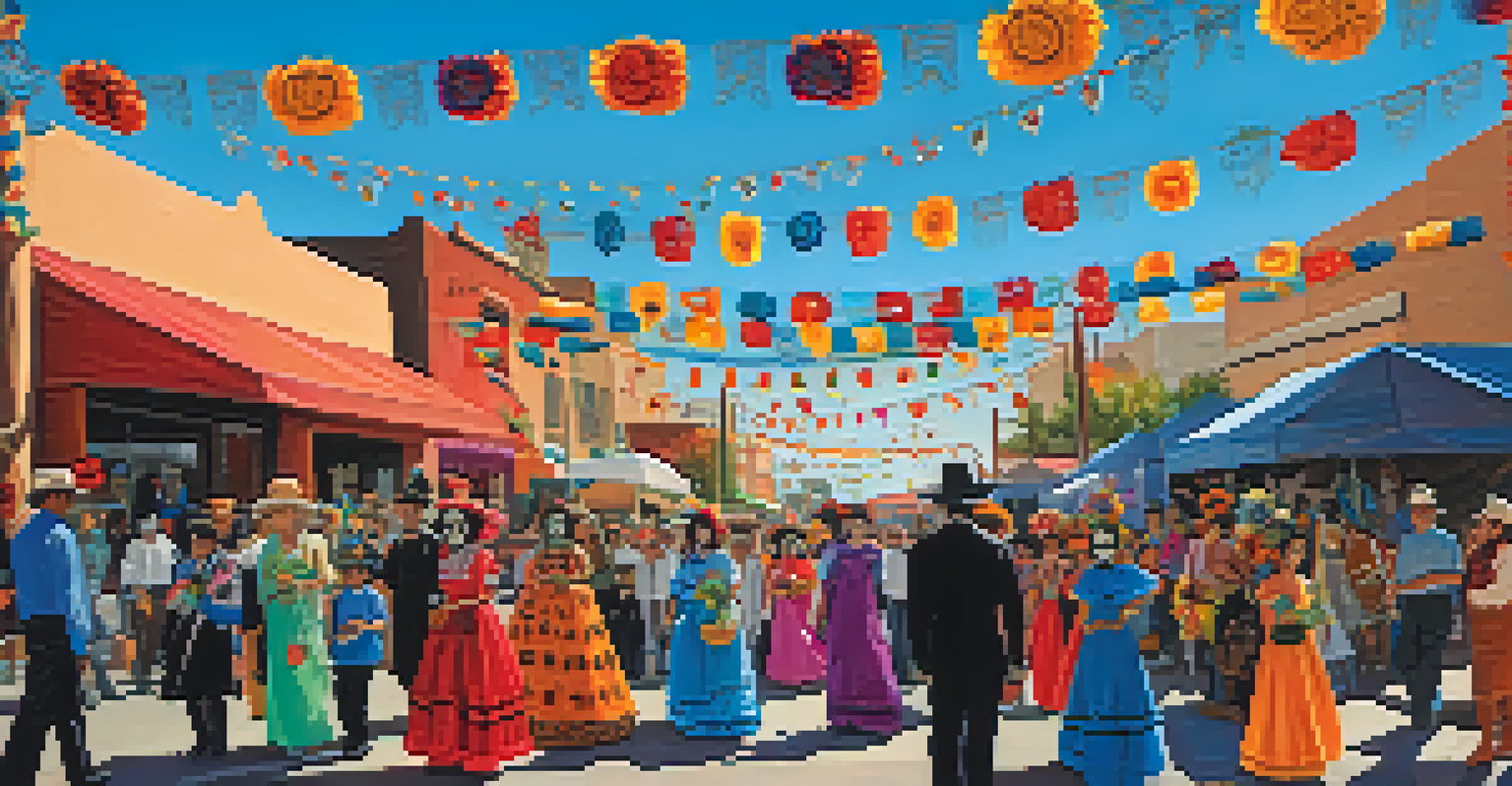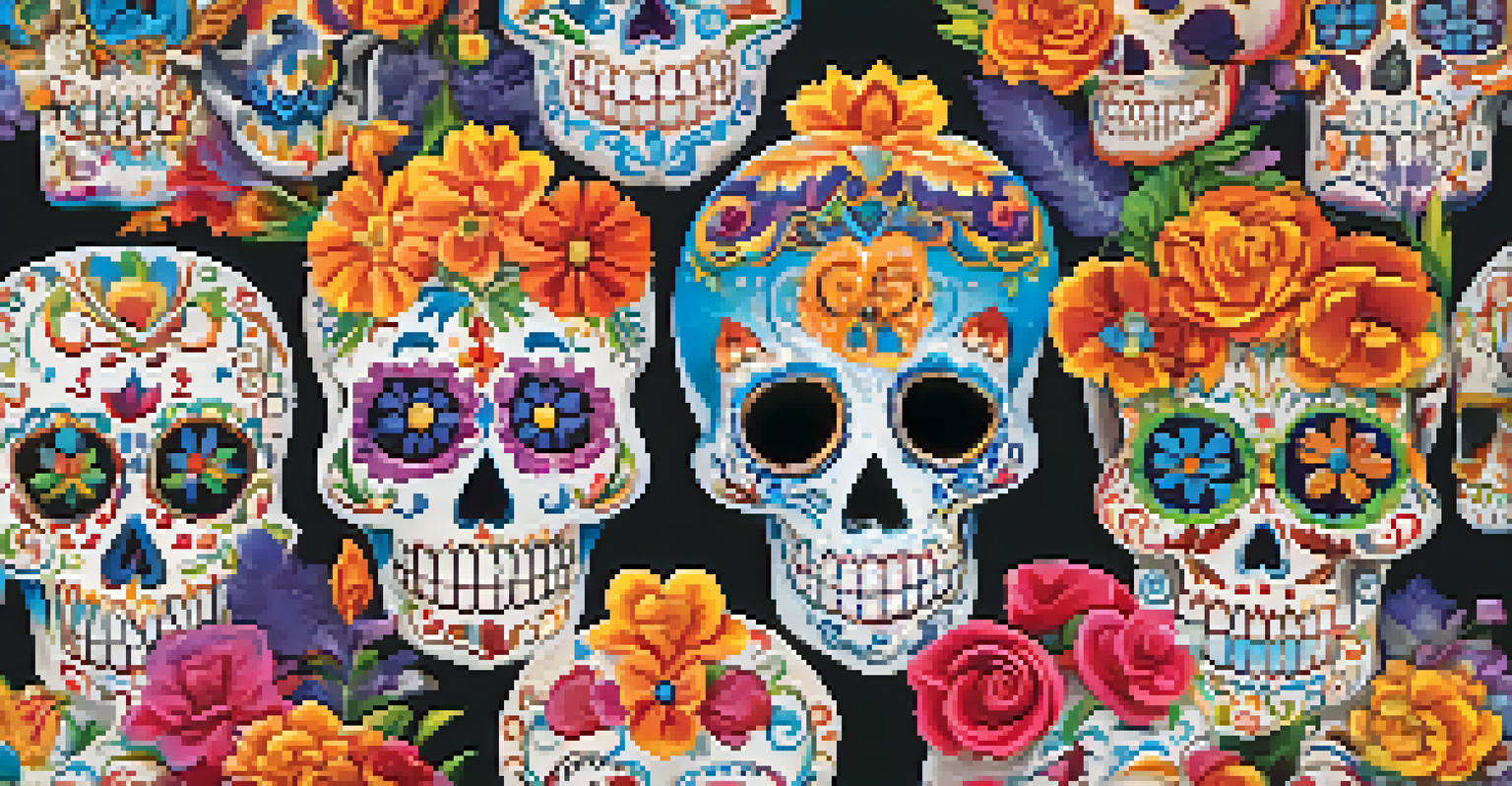Tucson's Annual Dia de los Muertos Festival: A Colorful Tribute

Understanding the Significance of Dia de los Muertos
Dia de los Muertos, or Day of the Dead, is a cherished Mexican tradition that honors deceased loved ones. It's not just a day of mourning; rather, it's a vibrant celebration of life and memory. Families create altars, or ofrendas, adorned with photos, favorite foods, and flowers to welcome spirits back for a day of reunion.
To forget one's ancestors is to be a brook without a source, a tree without a root.
This festival beautifully blends indigenous beliefs with Catholic traditions, showcasing how cultures evolve while retaining deep-rooted customs. In Tucson, this celebration has grown to reflect the city’s diverse community, inviting everyone to participate in honoring those who have passed.
The colorful imagery associated with Dia de los Muertos, like sugar skulls and marigolds, serves as a reminder that death is a natural part of life. Each element holds meaning, fostering a sense of connection between the living and the departed.
Tucson's Festival: A Community Gathering
Every year, Tucson transforms into a canvas of colors and emotions during its Dia de los Muertos Festival. This annual event attracts thousands of attendees who come together to celebrate, share stories, and remember their loved ones. The festival fosters a sense of community, allowing participants to connect through shared experiences and traditions.

Vendors line the streets, offering everything from traditional foods like pan de muerto to handmade crafts and art. This market-like atmosphere encourages attendees to immerse themselves in the culture, learning about the significance of various symbols and practices associated with the festival.
Dia de los Muertos: A Celebration of Life
Dia de los Muertos honors deceased loved ones through vibrant celebrations that blend indigenous and Catholic traditions.
Local musicians and performers enhance the festive spirit, showcasing traditional dances and music that honor the cultural heritage of the event. This blend of celebration and remembrance creates an atmosphere of joy and reflection, making Tucson's festival truly unique.
Key Attractions at the Festival
One of the standout attractions at Tucson's Dia de los Muertos Festival is the community altar display. Families and groups come together to create elaborate altars that reflect their personal connections to the deceased, making each one a unique tribute. These altars often feature intricate decorations, showcasing the talent and creativity of the community.
Death is nature's way of telling you to slow down.
Another highlight is the lively procession, where participants don traditional attire and carry beautiful decorations through the streets. This parade not only celebrates the festival but also raises awareness of the significance of Dia de los Muertos. It's a vibrant expression of culture that captivates both locals and visitors alike.
Art installations scattered throughout the festival grounds further enhance the experience. These pieces often explore themes of life, death, and remembrance, prompting introspection and conversation among attendees. The combination of art, culture, and community makes Tucson's festival a memorable event.
Traditional Foods to Savor
No festival is complete without delicious food, and Tucson's Dia de los Muertos is no exception. Traditional dishes like tamales, tacos, and mole are available, offering a taste of authentic Mexican cuisine. Food stalls not only serve as a source of sustenance but also bring people together to share a meal in remembrance of loved ones.
One must-try treat is pan de muerto, a sweet bread shaped like a skull, symbolizing the cycle of life and death. Families often bake this special bread at home, adding a personal touch to their festivities. Sampling these traditional foods provides a deeper understanding of the cultural significance behind the flavors.
Tucson's Festival: A Community Event
Tucson's Dia de los Muertos Festival fosters community connections and inclusivity, drawing diverse participants to celebrate shared cultural heritage.
The diverse culinary offerings at the festival introduce attendees to a rich array of flavors and traditions. It’s an opportunity to celebrate the heritage of the community while enjoying the vibrant atmosphere that the festival brings.
Art and Craftsmanship: A Visual Delight
Art plays a pivotal role in Tucson's Dia de los Muertos Festival, with local artists showcasing their talents through various mediums. From vibrant paintings to intricate crafts, the festival serves as a platform for artists to express their interpretations of life and death. This celebration of creativity enriches the overall experience for festival-goers.
Participants can find beautifully crafted sugar skulls, papel picado (cut paper), and hand-painted ceramics, each piece telling a story of its own. These handmade items not only serve as decorations but also as meaningful tokens of remembrance, making them perfect for altars or as gifts.
Engaging with the art at the festival allows attendees to connect with the cultural significance of Dia de los Muertos. It highlights the importance of preserving traditions while encouraging new interpretations, ensuring that this vibrant celebration continues to evolve.
Family-Friendly Activities to Enjoy
Tucson's Dia de los Muertos Festival is designed to be a family-friendly event, offering a range of activities for all ages. Kids can engage in arts and crafts stations, creating their own sugar skulls or decorating papel picado. These hands-on experiences provide a fun way to learn about the traditions while fostering creativity.
Storytelling sessions and puppet shows further enrich the festival experience, introducing children to the cultural narratives surrounding Dia de los Muertos. These engaging activities not only entertain but also educate young minds about the importance of remembrance and family connections.
Culinary and Artistic Traditions
The festival showcases traditional foods and local artistry, enriching the cultural experience while emphasizing the importance of remembrance.
By including family-oriented activities, Tucson's festival ensures that the spirit of Dia de los Muertos is passed down to future generations. It creates a welcoming environment where families can bond, reflect, and celebrate together.
The Impact of Dia de los Muertos on Tucson Culture
Tucson's Dia de los Muertos Festival has become a cornerstone of the city's cultural identity, reflecting its rich history and diverse community. The event fosters a sense of belonging, drawing in people from various backgrounds to celebrate a shared cultural heritage. This inclusivity not only strengthens community bonds but also promotes understanding and appreciation of different traditions.
As more people participate in the festival, it has grown to include elements from various cultures, making it a melting pot of traditions. This evolution showcases how Tucson embraces its multicultural spirit, allowing for a dynamic celebration that resonates with many.

The festival's impact extends beyond the day itself, influencing local art, cuisine, and community initiatives. It encourages ongoing conversations about life, death, and remembrance, ensuring that the values of love and respect for ancestors remain alive in Tucson's vibrant culture.